 |
 |
 |
| |
No effect of subtype on susceptibility and virologic response to TPV/r for treatment experienced patients
|
| |
| |
Reported by Jules Levin
XVII HIV Drug resistance Workshop
June 10-14, 2008
Sitges, Spain
Richard Bethell1, David B Hall2, John Baxter3, Jonathan Schapiro4, Charles Boucher5, Joseph Scherer6
1Boehringer Ingelheim (Canada) Ltd, Laval, Canada; 2Boehringer Ingelheim Pharmaceuticals, Ridgefield, CT, USA; 3Cooper Hospital/UMDNJ-Robert Wood Johnson Medical School, New Jersey, USA;
4National Hemophilia Center, Israel; 5Erasmus Medical Center Rotterdam, the Netherlands; 6Boehringer Ingelheim Pharmaceuticals, Ingelheim, Germany
AUTHOR CONCLUSIONS
Our study was limited by the small number of non-B patients undergoing susceptibility testing and participating in the RESIST studies. Therefore all non B subtypes were grouped together for the main analyses. Thus it is difficult to address each subtype individually, such as CRF01_AG, regarding susceptibility and virologic response. Such analysis for each subtype would require larger numbers of patients and is difficult in the current setting.
Phenotypic susceptibility to TPV/r was not reduced among patients infected with non-B subtypes participating in the study.
Although genotypic scores show higher baseline results for non-B than B samples, non-B patients did not have inferior responses, suggesting that this difference was not clinically significant.
Further investigation and analysis will be necessary to develop a full understanding of the role of resistance-associated polymorphisms in response to TPV/r for patients infected with different non-B subtype viruses.
TPV/r is a viable treatment option for treatment-experienced subtype B and non-B patients.
ABSTRACT
Objectives: Differential effects of HIV-1 subtype on TPV susceptibility for ARV-naļve patients have recently been presented. Moreover, the TPV unweighted score (TUS) predicts reduced response to TPV/r in some naļve, non-B subtype patients. Subtype differences in phenotypic and genotypic susceptibility and virologic response to TPV/r in treatment-experienced patients were therefore explored.
Methods: The RESIST trials entered 120 (55 on TPV/r) non-B subtype infected patients enabling a comparison of phenotypic (Antivirogram) and genotypic susceptibility and TPV/r response rates between B and non-B patients. Comparisons of subtype and virtual phenotype were performed on the baseline viruses from the 3050 treatment-experienced patients screened for participation in RESIST.
Results: Phenotypic susceptibility between subtype B (N=448 with IC50 FC) and non-B (N=29 with IC50 FC) patients were similar among RESIST patients, with median [IQR] values of 1.0 [0.5,3.5] for non-B and 1.8 [0.8,3.7] for B patients (p=0.3765). Using all screened patients (N=3050), the virtual phenotypes were also similar between subtype B (N=2845 with Virtual phenotype) and most non-B subtype (N=205 with Virtual Phenotype) patients, with median [IQR] values of 1.5 [0.9,3.0] and 1.4 [0.9,2.5], respectively (p=0.1413). The TPV unweighted score (TUS: p<0.0001), TPV weighted score (TWS: p=0.0018) and ANRS (p<0.0001) had significantly higher scores in non-B patients than B patients. In the RESIST population, there was no association between subtypes and week 48 response rates (VL<50) or effect of treatment regimen (B: difference between TPV/r and CPI/r response rates =13.2%; non-B: difference = 12.3%). TWS was the only score (unlike Stanford, Rega and Virtual Phenotype) to be significantly associated with week 8 (VL reduction; p=0.0187) and Week 48 response (VL<50; p=0.0212) in non-B patients.
Conclusions: Phenotypic susceptibility to TPV/r is not reduced among non-B subtypes studied. Although genotypic scores show higher baseline results for non-B than B samples, non-B patients do not have inferior responses, suggesting that this difference is not clinically significant. Further investigation and analysis will be necessary to develop a full understanding of the role of resistance-associated polymorphisms in response to non-B subtype viruses. TPV/r is a viable treatment option for treatment-experienced subtype B and non-B patients.
INTRODUCTION
The first score derived for interpretation of HIV protease genotype with respect to susceptibility to tipranavir (TPV) [1] included several amino acids that are observed as polymorphisms in various subtypes of HIV-1 virus, which led to higher scores being predicted in some non-B subtype infected patients. This has resulted in uncertainty regarding the potential use of tipranavir/ritonavir (TPV/r) in patients with non-B infections [2,3], and was among the motivations for the development of a weighted score for predicting responses to TPV/r [4]. The weighted score eliminated the 69K polymorphism and reduced the weight of
other polymorphisms. In contrast, several studies of antiviral susceptibility have found that different subtypes of HIV-1 from treatment naļve patients have not shown any systematic differences in the susceptibility of non-B subtypes [5,6,7]. In the present study, we investigated the clinical response of the patients infected with non-B subtypes of HIV-1 who were enrolled in the RESIST studies, and assessed the performance of the published methods for the prediction of virologic response in this subset of patients.
METHODS
The RESIST trials entered 120 non-B subtype infected patients and 1344 B subtype patients. Phenotypic testing (Antivirogram) was performed on 29 non-B subtype and 419 B subtype screening specimens. Virtual phenotype analysis was performed on all genotypic sequences. The RESIST trials entered 55 non-B subtype infected patients in the TPV/r treatment arm, enabling a comparison of phenotypic (Antivirogram) and genotypic susceptibility, and TPV/r response rates between B and non-B patients. Analyses included an adjustment for the Background Activity Score, a trial-specific genotypic susceptibility score [8]. Comparisons between subtypes for virtual phenotype and other genotypic TPV scores were performed on the screening viruses from the 3050 treatment-experienced patients screened for participation in RESIST.
RESULTS
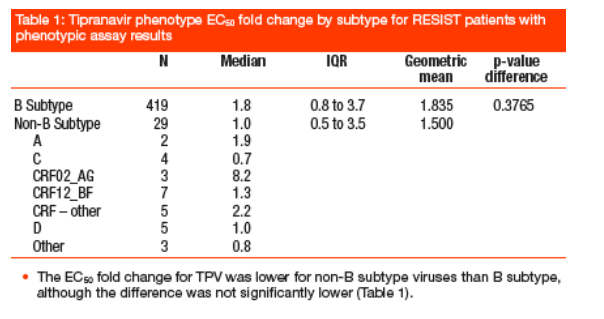
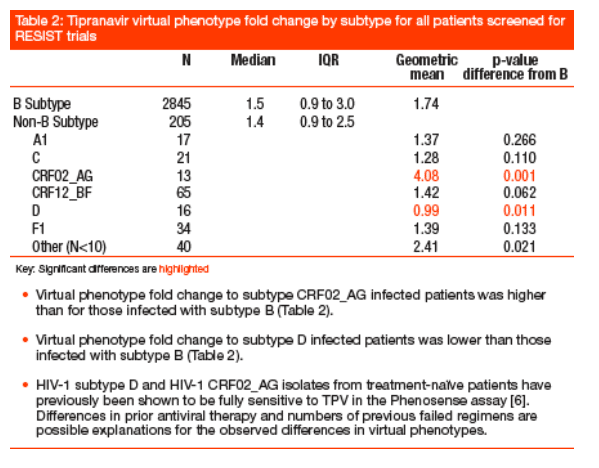
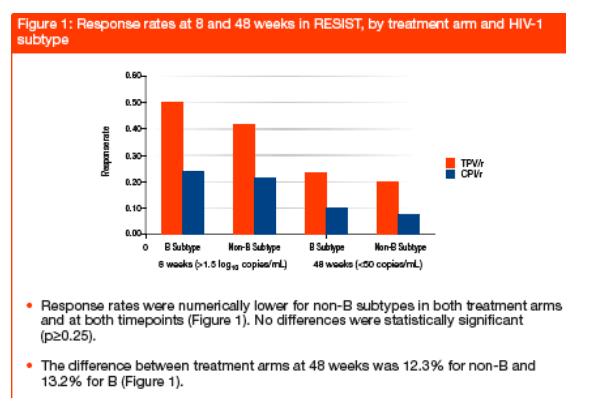
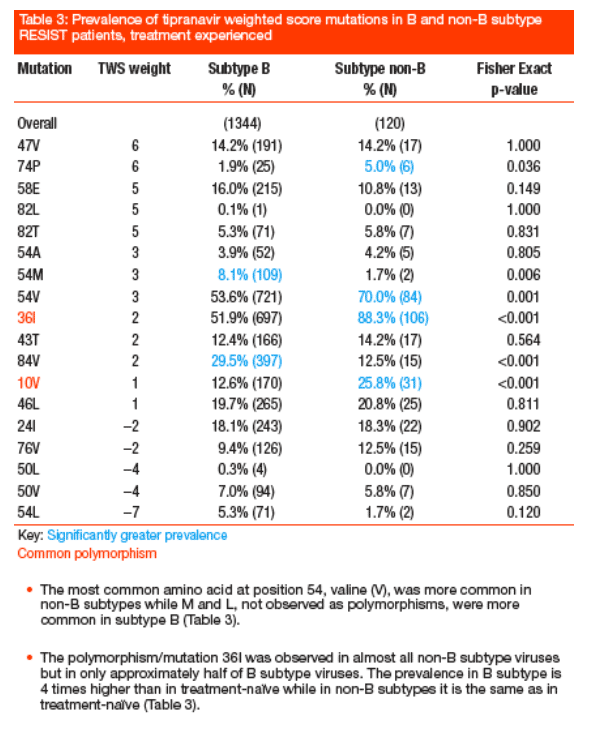
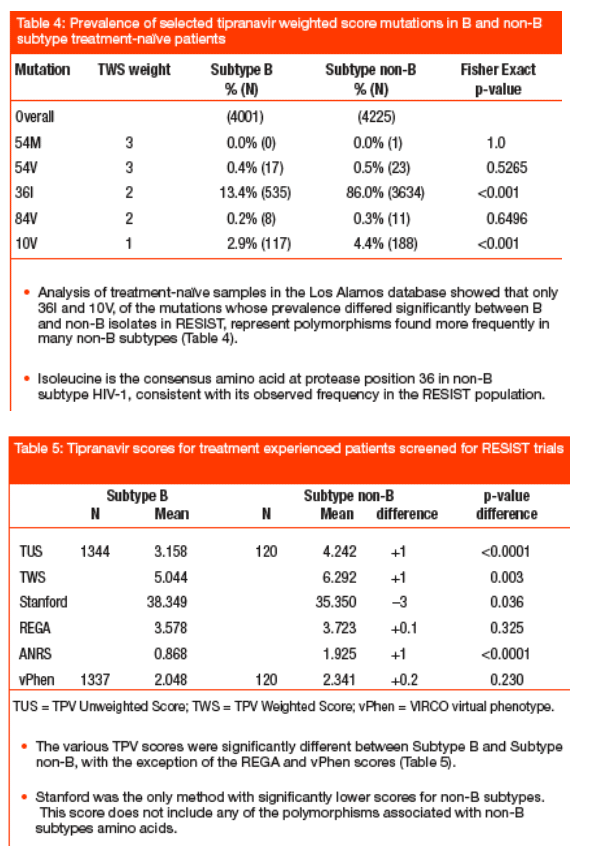
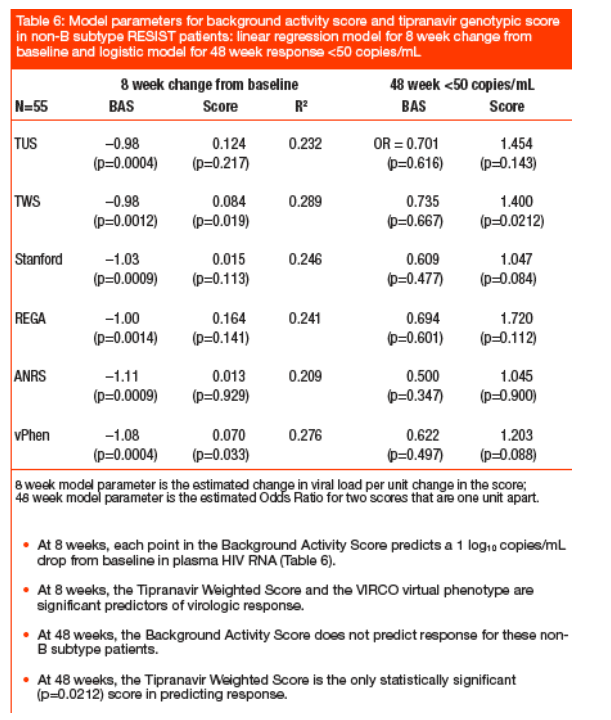
REFERENCES
1. Baxter JD, Schapiro JM, Boucher CA, Kohlbrenner VM, Hall DB, Scherer JR, Mayers DL. Genotypic changes in human immunodeficiency virus type 1 protease associated with reduced susceptibility and virologic response to the protease inhibitor tipranavir. Journal of Virology 2006; 80:10794-801.
2. Sturmer M, Dauer B, Haberl A, Muller A, Gute P, Klauke S, Staszewski S, Doerr HW, Lecocq P, Van Houtte M. Subtype-dependent increase of the drug resistance score for tipranavir in PI-naļve HIV-1 infected patients: Bias in the algorithm or lower genetic barrier in non-B subtypes. 11th European AIDS Conference/EACS, October 24-27 2007, Madrid, Spain (Poster # P3.4/13)
3. Maillard A, Depatureaux A, Le Guillou H, Garnier E, Ferre V, Vallet S, Giraudeau G, Payan V, Plantier JC, Ruffault A. Impact of HIV-1 diversity on boosted protease inhibitor resistance scores. 11th European AIDS Conference/EACS, October 24-27 2007, Madrid, Spain (Poster # P3.4/21)
4. Scherer J, Boucher CA, Baxter JD, Schapiro JM, Kohlbrenner VM, Hall DB. Improving the prediction of virologic response to tipranavir: the development of a tipranavir weighted mutation score. 6th European HIV Drug Resistance Workshop 26-28 March, 2008, Budapest, Hungary (Poster # 94).
5. Abecasis AB, Deforche K, Bacheler LT, McKenna P, Carvalho AP, Gomes P, Vandamme AM, Camacho RJ. Investigation of baseline susceptibility to protease inhibitors in HIV-1 subtypes C, F, Gan d CRF02_AG. Antiviral Therapy 2006; 11:581-589
6. Bonneau PR, Lie Y, Bethell RC. Tipranavir displays similar in vitro antiviral activity against non-subtype B clinical isolates of HIV-1 compared with isolates from subtype B. 11th European AIDS Conference / EACS, October 24-27 2007, Madrid, Spain (Poster # P3.3/02)
7. Poveda E, de Mendoza C, Parkin N, Choe S, Garcķa-Gasco P, Corral A, Soriano V. Evidence for different susceptibility to tipranavir and darunavir in patients infected with distinct HIV-1 subtypes. AIDS 2008; 22:611-616
8. Hall DB, Baxter JD, Schapiro JM, Boucher CAB, Piliero P, Scherer J. Linear modeling to estimate the contribution of each drug component of the regimens of highly treatmentexperienced patients in RESIST. 11th European AIDS Conference/ EACS, October 24-27 2007, Madrid, Spain (Poster # P3.4/22)
|
| |
|
 |
 |
|
|